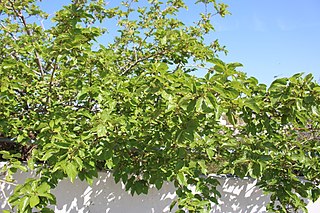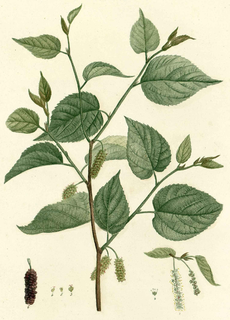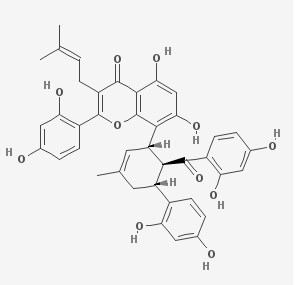
Morus, a genus of flowering plants in the family Moraceae, consists of diverse species of deciduous trees commonly known as mulberries, growing wild and under cultivation in many temperate world regions. Generally, the genus has three well-known species ostensibly named for the fruit color of the best-known cultivar: white, red, and black mulberry, with numerous cultivars, The name "white mulberry" came about because the first specimens named by European taxonomists were a cultivated mutation prized for their white fruit, but wild trees bear black fruit like other mulberries. White mulberry is native to South Asia, but is widely distributed across Europe, Southern Africa, South America, and North America. The species most preferred by the silkworm, Morus alba is regarded as an invasive species in Brazil and the United States.

Morus alba, known as white mulberry, common mulberry and silkworm mulberry, is a fast-growing, small to medium-sized mulberry tree which grows to 10–20 m (33–66 ft) tall. It is generally a short-lived tree with a lifespan comparable to that of humans, although there are some specimens known to be more than 250 years old. The species is native to India, Central China and is widely cultivated and naturalized elsewhere.
Chinese mulberry is a common name for several trees and may refer to:

Biograd na Moru, shortened to simply Biograd, is a town in northern Dalmatia, Croatia and is significant for being another capital of the medieval Kingdom of Croatia. Biograd is administratively part of the Zadar County. It is located on the Adriatic Sea coast, overlooking the island of Pašman, on the road from Zadar and Sukošan towards Vodice and Šibenik.

Morus rubra, commonly known as the red mulberry, is a species of mulberry native to eastern and central North America. It is found from Ontario, Minnesota, and Vermont south to southern Florida, and west as far as southeastern South Dakota, Nebraska, Kansas, and central Texas. There have been reports of isolated populations in New Mexico, Idaho, and British Columbia.
The University of New Mexico Arboretum is an arboretum extending throughout the University of New Mexico campus in Albuquerque, New Mexico.
Morus serrata, known as Himalayan mulberry, is a species of mulberry native to the Himalaya and the mountains of southwestern China, at altitudes of up to 2300 m.

Morus nigra, called black mulberry or blackberry, is a species of flowering plant in the family Moraceae that is native to southwestern Asia and the Iberian Peninsula, where it has been cultivated for so long that its precise natural range is unknown. The black mulberry is known for its large number of chromosomes, 308.

Dihydromorin is a flavanonol, a type of flavonoid. It can be found in plants of the family Moraceae including Morus nigra, in Morus alba, Maclura pomifera, in the jackfruit and in Artocarpus dadah.

Oxyresveratrol is a stilbenoid. It is found in the heartwood of Artocarpus lakoocha and in the traditional drug 'Puag-Haad' made from it. It is also the aglycone of mulberroside A, a compound found in Morus alba, the white mulberry.

Mulberrofuran G is a bio-active compound isolated from the bark of Morus alba.

Kuwanon G is an antimicrobial bombesin receptor antagonist, isolated from Morus alba.

Moracin M is a phosphodiesterase-4 inhibitor isolated from Morus alba.
Morus celtidifolia, the Texas mulberry, is a plant species native to South America, Central America, Mexico, and the southwestern United States, ranging from Argentina north as far as Arizona and Oklahoma. In the USA, it grows in canyons and on slopes, usually near streams, from 200–2,200 m (660–7,220 ft) elevation. It is very often referred to as "Morus microphylla," including in Flora of North America, but recent studies suggest that these names are synonymous with M. celtidifolia holding priority.

The Mulberry garden, originally Morušová zahrada in Czech, is a cottage garden in the Czech Republic, situated in the Czech Central Uplands in the village Režný Újezd, 7 kilometres (4.3 mi) northwest of the town Lovosice. The garden was established in 2014 by local gardeners admiring the English cottage garden style. Apart from different kinds of plants such as perennial plants, annual plants, and bulbs, several uncommon fruit trees are grown, especially various mulberry varieties. Mulberry garden is located along the green tourist track to Boreč hill in the grounds of former Gentlemen's farm, house no. 2.

Morus indica is a member of the genus Morus, of the family of flowering plants Moraceae, commonly known as the mulberry family. As with other mulberries, Morus indica is a deciduous tree. Morus indica is native to the temperate and sub-tropical Himalayan region. It is currently cultivated in India, China, Japan, and East Africa.
Morus mongolica, also described as Morus alba var. mongolica, is a woody plant native to mountain forests in Mongolia, China, Korea, and Japan. Common names for Morus mongolica include Mongolian mulberry, meng sang (China), and ilama by native people in the namesake region of Mongolia. Similar to Morus notabilis, Morus mongolica is an uncultivated mulberry.












